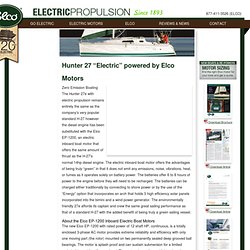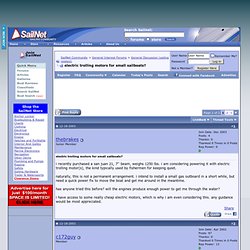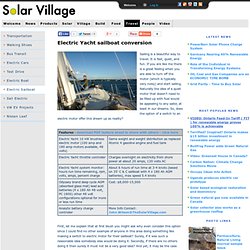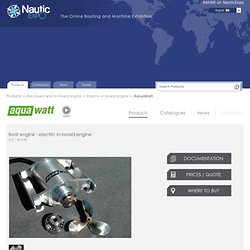

Electric boat. While a significant majority of water vessels are powered by diesel engines, with sail power and gasoline engines also remaining popular, boats powered by electricity have been used for over 120 years.

Electric boats were very popular from the 1880s[1] until the 1920s, when the internal combustion engine took dominance. Since the energy crises of the 1970s, interest in this quiet and potentially renewable marine energy source has been increasing steadily again, especially as solar cells became available, for the first time making possible motorboats with an infinite range like sailboats. The first practical solar boat was probably constructed in 1975 in England.[2] History[edit] The first electric boat was developed by Moritz von Jacobi in 1839 in St Petersburg, Russia - a 24-foot (7.3 m) boat which carried 14 passengers at 3 mph. It took more than 30 years of battery and motor development before they began to be deployed in any numbers. Components[edit] Charger[edit] Electric Inboard Boat Motors. Zero Emission Boating The Hunter 27e with electric propulsion remains entirely the same as the company’s very popular standard H-27 however the diesel engine has been substituted with the Elco EP-1200, an electric inboard boat motor that offers the same amount of thrust as the H-27′s normal 14hp diesel engine.

The electric inboard boat motor offers the advantages of being truly “green” in that it does not emit any emissions, noise, vibrations, heat, or fumes as it operates solely on battery power. The batteries offer 6 to 8 hours of power to the engine before they will need to be recharged. The batteries can be charged either traditionally by connecting to shore power or by the use of the “Energy” option that incorporates an arch that holds 3 high efficiency solar panels incorporated into the bimini and a wind power generator. Electric propulsion. I have a little experience with electric aux. power having spent a few days messing about on a little gaff rigger with an electric system.

Here are my initial conclusions. Electric works best simple boats and for daysailer/overnighters. There really is a limited amount of electrical storage capacity so you don''t have the reserves to operate refrigeration or an autopilot, or some of the complicated electronic systems that have become so popular. You lack the kind of reserves to run navigation lights for several nights in a row. You lack sufficient reserves to motor upwind for a six or eight hours straight without either having a huge battery system or else spending a 8 to 10 hours on a charger. Most electrics lack the solar and wind generator capacity to regenerate solely from the charger systems on board. Electric trolling motors for small sailboats?
The sailing school I went to allowed you to charter their school boats, Tanzer 22s, for day sails.

They had 12 boats or so, but only three outboards. If you didn''t get there early, you had to get towed out and back. So I pulled a trolling motor off of my small aluminum fishing boat (35-pounds of thrust) and brought it with me for the Tanzer. Got me out away from the dock and out on the water, and back with no problem. In later years I used it on a Catalina 22 with similar results. They make 55-pound thrust saltwater motors and I was considering one of those to replace an old Johnson 9.9 that was a bit finicky. Electric Sailboat - Solar Village - Solar power you can use. Sailing is a beautiful way to travel.

It is fast, quiet, and fun. If you are like me there is a great feeling when you are able to turn off the motor (which is typically very noisy) and start sailing. Naturally the idea of a quiet motor that doesn't need to be filled up with fuel would be appealing to any sailor, at least in our dreams. EBAA Home. The Electric Boat Association (EBA) Transatlantic21: The world's first crossing of the Atlantic on a solar boat. The story of solar powered boats.
Solar boats are electrical boats, with independent, quiet and clean engines, whose batteries store free energy from the sun.

On the seas and inland waters as well as along their banks there are only a few connections to public electricity mains. People who live on inland waterway crafts, sailing boats, space stations and houseboats, are dependent on batteries, just as the owners of electrically propelled boats. But batteries sometimes discharge and must be replenished. One of the most elegant solutions for this is solar electricity. Electric outboard motors and electric inboard motors. Above the Waterline's New Electric Propulsion for Sailboats. Santa Barbara, CA ( PRWEB ) September 14, 2008 — Above the Waterline’s New Electric Drive revolutionizes sailboat propulsion. These drives are quieter, smoother, and more powerful than any diesel.
Power is available at the flick of a switch…there is no waiting for an engine to start and warm up. Rapid acceleration, braking and accurate slow speed control improve docking and piloting. The motor can run continuously at 4.7 KW and can surge to 9 KW for collision avoidance, an important safety feature. ATW drives have extended range capabilities. CLEAN, GREEN & QUIET Marine Propulsion Systems! Sea-EV Electric Sailboat Conversion. Boat motor : electric in-board motor - 10 - 30 kW - AquaWatt. Advanced inboard electric propulsion systems with AC motors and digital motor controllers 4,3 - 40 kW , 48 V to 120 V DC power supply Aquawatt offers one of the worlds most unique high powered electric marine propulsion systems for recreational boats to date.

Instead of petrol smell or loud noise a high tech AC motor provides clean power with almost no maintenance and full thrust at all rotation speeds. If you are looking for a real sustainable investment, this is the solution for any motor- or sailing boat. The huge ad-vantage compared to a petrol or diesel engine is the high torque at all speeds and the variability of your power source. Traditional lead acid batteries, advanced lithium batteries, solar panels or even a gas- or diesel generator.
The installation of any inboard motor system should be planned and executed by a boat builder. For more informations and price list, please visit the aquawatt homepage. Converting sailboat Tranquility to electric propulsion using ElectricYacht.com system. 100% Electric Sailboat Motor - Part 2.